One of the things that makes APU a unique place to study is our Block class format. These special classes begin the semester with a “block” — four weeks of focused, hands-on learning in the field — followed by 11 weeks of traditional classroom instruction. Blocks provide opportunities for students to learn in new and meaningful ways, often traveling around the state (or beyond), living in community with their academic cohort.
From the snowy lawn of Grant Hall to the capitals of Scandinavia, here are some glimpses at what our students were up to during the first Block of 2020…
The Science of Creativity
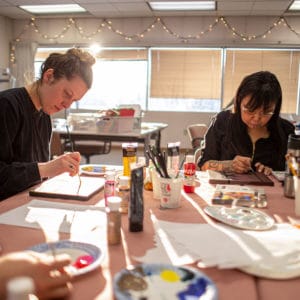
Therapy Students use paint to channel introspection and growth.
In the psychology course Creativity for Healing and Growth, students are encouraged to access and understand the creative process so they can use it for self-understanding. The first half of the Block was dedicated to gaining an academic understanding of the science of creativity. After exploring the research, students dove into a practical exploration, aided by local artists. They learned from APU’s Artists-in-Residence Joe and Martha Senungetuk; toured Our Voices: An Indigenous Art Ceremony with James Temte, one of the exhibit’s curators and artists; and studied the use of expressive arts in social justice and therapy. Over the course of the semester, each student will apply what they learned to a creative project that will be shared with the class this spring.
A Frosty Labyrinth
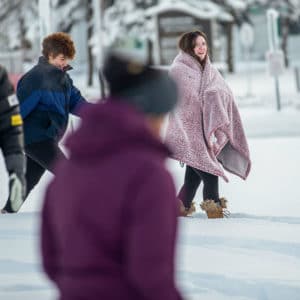
Undergrad, Corinne Oberman, helps students build a labyrinth in front of Grant Hall.
While some Block classes took their work to the field, one took it to the lawn. Undergraduates in Rosanne Pagano’s Mythology and Folklore class braved sub-zero temperatures as they combined service learning with a lesson on labyrinths in mythology. Working with APU Chaplain Brian Anderson, Pagano’s students built their own real-life labyrinth in the powdery snow in front of Grant Hall. It’s the second year in a row that Pagano’s January Block has brought the labyrinth, an archetype of seeking, to life in front of APU’s flagship building.
Replicating At-Sea Research
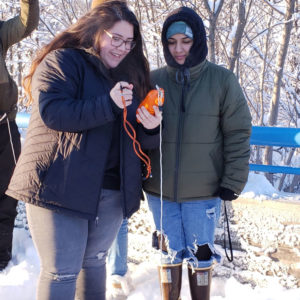
Students drop a CTD sensor into Anchorage’s Westchester Lagoon.
Mythology wasn’t the only subject that brought students out in the cold during this January Block. Students in the Oceanography Block battled frigid temperatures and icy conditions at Westchester Lagoon as they gained hands-on experience with research techniques. The class deployed a CTD sensor, a scientific instrument that calculates salinity by measuring electrical conductivity; assess depth by gauging pressure; and measures water temperature. CTD data are used to understand the physics, chemistry and biology of the ocean water column. By working at the downtown Anchorage lagoon, Oceanography students were able to replicate methods that are typically conducted from research ships.
Going to Extremes, Nordic-Style
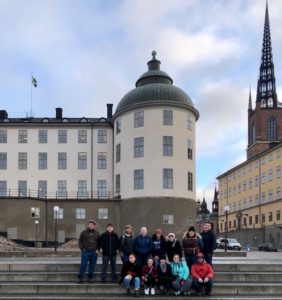
Literature students pose for a photo in Stockholm Sweden.
This year’s Nordic Culture and Literature travel course took students on a ten-day journey through Sweden, Finland, and Estonia. Visiting the capitals of Stockholm, Helsinki, and Tallinn, students learned the history of each nation from local guides before exploring the bustling and ancient corners of each city for themselves. While abroad, students took an in-depth look at Nordic society, analyzing diverse views on historical and current issues as they enjoyed once-in-a-lifetime experiences like viewing old and rare texts at the University of Uppsala Library in Sweden, and taking a plunge in the Baltic Sea after a traditional Finnish sauna. Upon return, they were asked to reflect on the travel experience and place it within the context of their own cultural background.
And more:
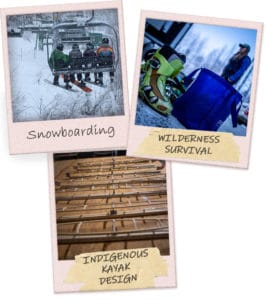
Snowboarding, Wilderness Survival and Indigenous Kayak Design classes.
